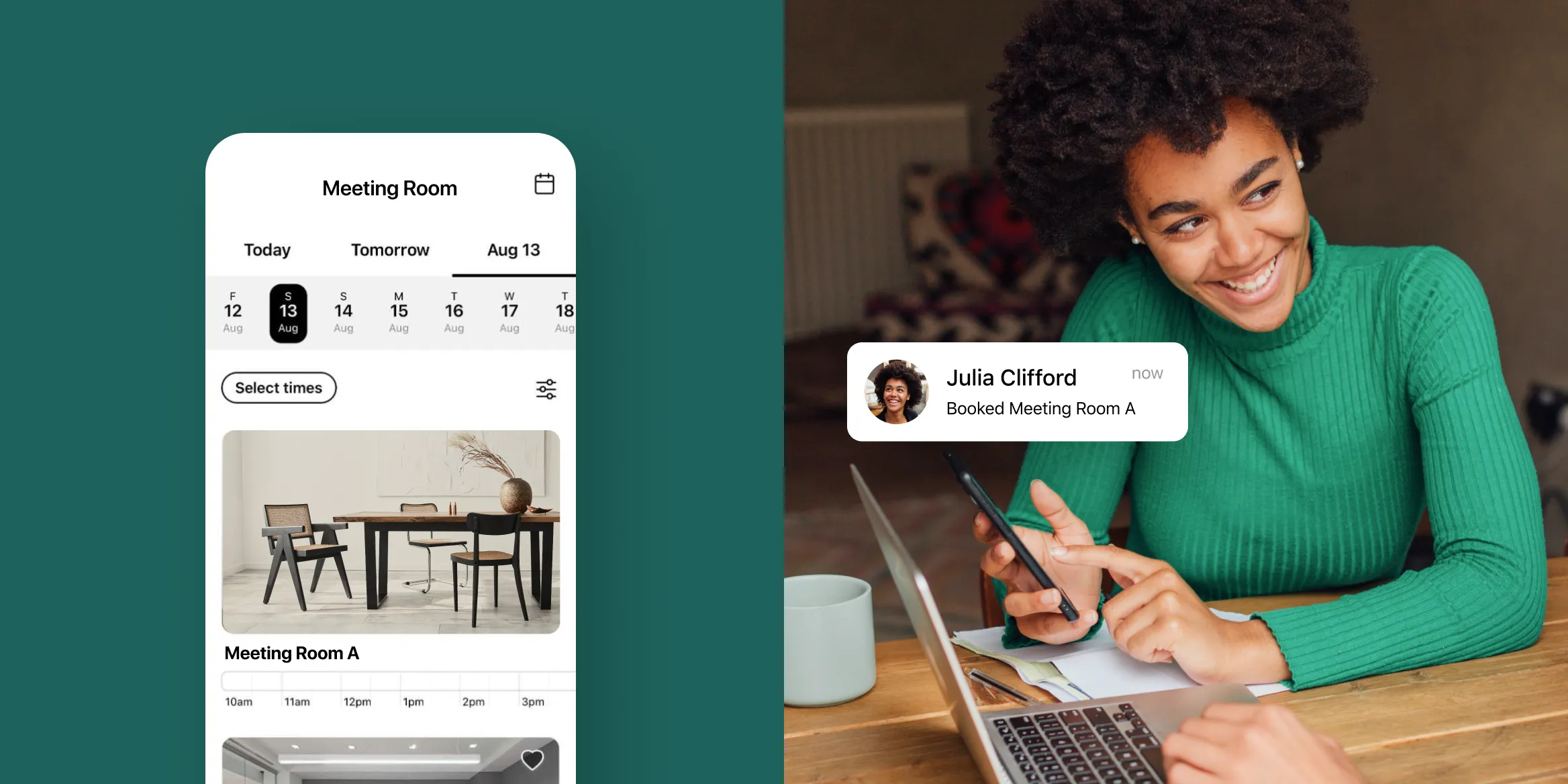With the coworking industry set to grow 30% by the year 2030, there’s a reason why we’re seeing more and more aspiring coworking owners and operators enter the market.
After helping coworking owners and operators start successful businesses for nearly a decade, we’ve learned what it takes to be successful in the flex space industry.
We’ll help you figure out the foundation of starting your coworking business, so you’ll be set up to succeed in the flex industry and beyond. If you’re considering opening a coworking business in your community, this is the guide for you.
Starting a coworking space can broadly be divided into four key steps:
- Determine your business strategy
- Define key operational pieces
- Develop a sales and marketing strategy
- Build a strong community and experience
We’ll unpack each of these steps in this guide, including what you need to do for each and why it’s critical to your overall success.
Determine your business strategy
First things first, you’ll need to figure out all of the essential foundational elements of your coworking business. This includes how your space will make money, if and when you’ll need a business plan, and where your space will be located.
1. Figure out your why
The first question to ask yourself before starting a coworking space is why.
Why do you want to start this business? What motivated you to choose coworking? Your reason for starting a coworking business will guide many of the future decisions that you make. Maybe you want to:
- Build a community of mission-driven people
- Make use of a pre-existing, under-utilized space like KoWorks
- Create a place where entrepreneurs can network and grow
- Capitalize on the the hybrid work trend
Kia Rahmani, Optix founder and CEO, started a coworking space after spending time in incubators in Silicon Valley. He wanted to create a collaborative space for start-ups in his hometown of Vancouver, Canada, much like he experienced in California.This was his why.
Start your 14-day free trial of Optix. No credit card required.

2. Create a business plan
Here’s a mistake we see far too often: aspiring coworking owners starting their business without a clear plan for how their space is going to make money. Considering 50% of coworking spaces are not profitable, this is crucial to consider.
Creating a coworking business plan will help you:
- Get a loan or receive funding
- Guide your short-term and long-term strategy
- Help you make important business decisions
For those who aren’t looking for funding, a business plan is a way of making sure you have a viable business before opening your doors. If you are applying for a loan or looking to receive funding, then a business plan will be a necessity.
3. Determine your business model
The primary way coworking spaces make money is by selling space in the form of hot desks, dedicated desks, meeting and conference room rentals, and private offices
However, there are a few other coworking revenue models to consider including:
- Additional amenities like gym and childcare facilities
- Workshops and paid events for members
- Virtual mailbox services
- Renting the space for external programs and events after hours
- Renting resources like TVs, podcasting equipment, and additional hardware
- Food and drink services
You don’t need to figure all of your revenue streams out right away. However, you should know what the breakdown of your space will be in terms of desk to office to meeting space ratio. Today, private offices are in demand.
“One thing I wish I knew before I started my coworking space is that in our market, locked offices would be in much higher demand than open coworking space.”
4. Figure out how you will fund your coworking space
When it comes to starting a coworking space, there are three main sources of funding:
- Self-funding: investing your own personal money into your business
- Investors: venture capital from investors. It will usually require you to give up a share of the company (equity) in return for an agreed upon sum of money
- Loans: borrowing money and paying back interest. There are many different loans available including a small business loan or a loan from a bank
Each form of funding comes with its own pros and cons. For that reason, many operators will mix multiple sources of funding to start their coworking space.
Funding models for coworking spaces: pros and cons
| Pro | Con | |
| Self-funding | Gives you complete control of your business including all decisions you make. | Can be risky if your business fails.
Many people do not have the capital to fund their space up front. |
| Investors | Oftentimes gives you access to a partner with business experience.
Offers a large amount of money that you couldn’t get otherwise. |
Requires you to give up shares in your business.
You will need to consult your investors before any major business decision is made. |
| Loans | Gives you access to funding without giving up shares in your company. | Interest payments can be very high.
May be hard to secure a loan from a bank depending on your financial situation. |
5. Pick the right location
Refining your coworking location strategy is a huge first step in opening your coworking space.
A location strategy consists of:
- The city you want to open in
- The type of building you’re looking for
- The size of the space you want
- The price range you’re willing to pay
- The demographic you’re looking to target
Select the top cities you want to open in and research everything from demographics to job growth. Make sure that the city and space you’re choosing to open in is aligned with what your target customers want, as well as the kind of community you’re looking to build.
6. Define your target market
Defining your target market, or ideal customer profile is a fundamental part of starting any business. This includes:
- What is their demographic (age, gender, occupation, income)
- What do they care about
- What problems do they have
- Why do they want a coworking space
It can be helpful to draw this person out or create a battlecard to help you remember who they are. This buyer persona tool from HubSpot can help bring your ICP to life so they’re always fresh in your mind.
7. Design your coworking space
When designing a coworking space, you need the space to be functional but inspiring, practical but welcoming, professional but homey, the list goes on and on.
When we think about designing a coworking space, these are the critical steps we recommend taking.
- Start with your business model
- Figure out what your needs are
- Configure a floor plan
- Begin the buildout
- Find the right furniture
- Deploy the right tech
- Stay agile and embrace experimentation
The biggest requirement is ensuring you create something that supports people in being their best, most productive selves.
"It's not just about creating a space, but more about cultivating a community. The aesthetics and amenities are crucial, but it's the relationships built and the atmosphere of collaboration that truly set a coworking space apart."
Define key operational pieces
An important part of starting a coworking space is figuring out how it’s going to operate — or as we like to say, “the meat and potatoes” of your business. Operations are always subject to change, but aligning on some key operational pieces early on will help you run your business as efficiently as possible.
8. Align on your initial membership plans and pricing
Structuring and pricing your coworking membership plans will set the tone for how your business generates revenue.
These are some of the most popular plans we see.
- Community plan: access to the virtual community and all events
- Hot desk plan: 8-20 days a month of hot desk use, 5-10 hours of meeting room rentals a month
- Private office: 24/7 access to their own secure office, meeting room rental allocation
- Virtual mail plan: access to virtual mail services and discounts on meeting rooms and desk bookings
- Weekender plan: Unlimited weekend access to hot desks
How you price these plans will depend on the market, your competitors, the amenities you offer, and how much money you need to generate each month for profitability.
9. Build out your team
Depending on the size and scale of your operations, you may need to hire staff for your coworking space.
The most common position that coworking operators hire for is a community manager. A community manager is responsible for engaging the community, managing bookings, and ultimately making people feel welcome and safe. The average cost of a full-time community manager is around $55,000 USD a year.
However, most operators opt not to hire staff right away and instead rely on technology to help them run their business. With Optix coworking software for example, many coworking space operators use Automations to follow-up with leads, collect overdue invoices, and handle back-end tasks in Optix. This allows early-stage operators to run much of the business themselves, improving profitability and simplifying starting a coworking business.
10. Plan out your coworking technology ecosystem
Technology is a huge part of the modern coworking space, but knowing where to start can be daunting. This is how we suggest building your coworking technology ecosystem:
- Start light: build the foundation of your stack with only the tools that you need and increase complexity as you grow
- Go high reward first: start with tools that will support the most time-intensive tasks, like managing bookings and invoicing
- Integrations are key: look for tools that work well together and integrate as much as you can
- Think about the future: go for tools that will be able to scale and evolve with you and your business
The most important thing to consider when you’re opening your first space is, what are the essential tools I need to run my business. Start with the essentials and expand as you grow.
11. Select your coworking space software
Part of an effective technology ecosystem is a great coworking space software.
Coworking platforms like Optix helps automate all of the day-to-day operations of running your business, effectively helping you engage your members and grow your business.
While you can implement coworking space software at any time, it’s easiest to get it up and running in your space at the beginning.
These are a few questions to ask yourself before getting started:
- What are my coworking space’s biggest operational challenges?
- What will best support my members?
- What other tools will I be using and will they integrate with my software?
- What kind of support will I be provided with long-term?
Wondering how software can help you start a coworking business? Reach out to a member of the Optix team today to get started.
Start your 14-day free trial of Optix. No credit card required.

Develop a sales and marketing strategy
Time and time again we hear from operators that the biggest challenge in their coworking business is acquiring new members and filling their sales funnel. For that reason, we highly recommend thinking about your marketing strategy as early as possible including how you will attract the kind of members you’re targeting.
12. Create an initial member acquisition strategy
Getting your first coworking members is an exciting challenge that will take some experimentation to get right. One of the more effective strategies we see for early-stage operators is promotional pricing.
Here, you price your membership plans at a cheaper rate for a set period of time in hopes of attracting new members. Then, you promote this discounted price using:
- Digital ads
- Social media
- Street teams
- In-person events
- Local business partnerships
The goal of this acquisition campaign is to generate buzz and bring people into the space, in hopes of building a lively community. Consider it a temporary tool to get people in the door and prove the value of the space itself.
13. Map out a long-term marketing plan
While offering a steep discount is a good way to get people in the door in the beginning, it isn’t a sustainable way to acquire customers. Having a solid marketing plan for your coworking space is essential to long-term growth.
A good marketing plan will include:
- Market research
- Target market
- Goals and objectives
- Strategy
- Marketing tactics
- Budget
Think about how many members you want to acquire in the next year. Now think about how you are going to get them. The most effective channels we typically see for coworking spaces is SEO and Google ads, but the potential for creativity is endless.
"Host a fun grand opening event that showcases your space and your offerings. Do everything you can to get the word out and when you give tours or answer questions, be excited about your space! Your passion for spacemaking will shine through, and it is contagious."
14. Outline exactly how you will differentiate yourself
Creating a differentiated offering for your space can help you combat the competition and keep your membership growing long-term – even when bigger chains are marching into your market.
Differentiation can be as elaborate as building a niche coworking space tailored to a hyper-targeted client base, or as simple as hosting really great events or having a well-defined brand.
Consider what will make your space different from your competitors, and what will make people choose your space over others. See if you can leverage these insights to create a desirable community that people choose — every time.
15. Create a sales strategy
Sales and marketing go hand-in-hand. Here are some questions to ask yourself when building out an effective sales process at your coworking space:
- How will you capture leads?
- What will you do with leads once they come through?
- How will you ensure you’re following up with your leads?
- Who will manage your customer relations?
- How will you incentivize deals to close?
You can use Automations in Optix to accomplish many of the tasks above, eliminating the need for a complex CRM system early in your coworking journey. Use Automations to automatically send email communications to leads including tour reminders, special discounts, and exclusive offers to help convert prospects into members.
Check out the Masterclass below to learn how to manage and nurture leads in Optix.
Build a strong community and experience
You’ve developed a business plan, designed your coworking space, and built out a stellar marketing plan that has members pouring in your space. Now it’s time to start to build the community you’ve always dreamed of.
16. Determine what kind of community you want to build
The number one reason people seek out coworking spaces is for community. Having a strong community element in your coworking space will help you attract and retain members. It can be the difference between a business and brand.
First, spend some time thinking about what a coworking community means to you. For some, building a coworking community means bringing people together to network and make new connections. For others, it means providing a safe space to express themselves.
Then, you can start thinking about the kind of community you want to build.
17. Connect with the greater local community
Coworking spaces and more often becoming hubs for the broader community. Connecting with the local community can help you build awareness of your coworking space, while getting a better understanding of what the needs of the community are.
- Go to local meet-ups at coffee shops or community centers
- Develop relationships with the businesses next door
- Develop an online community of local entrepreneurs on Facebook
The chances of you succeeding long-term are much higher if you start with the people first.
18. Develop strategies to engage your community
Community engagement is a hot topic for operators. At the end of the day, building an engaged community comes down to understanding your members and what they want from you.
Tactics to engage your coworking community:
- Organize monthly in-person events with complimentary food and drinks
- Send out a weekly newsletter sharing community news
- Set up a community feed in your space for members to connect
- Celebrate member birthdays, space anniversaries, and other significant days
- Set up webinars and virtual lunch-and-learns for members
“We take community for granted, yet it’s so pivotal in everything that you’re building. It’s a foundation that people rely on, yet we don’t connect it financially.”
19. Think about how to deliver an exceptional user experience
Coworking operators are in the hospitality business. At the end of the day, it’s all about how you create an unforgettable experience for your members. There are many ways that you can go about doing this:
- Complimentary, locally roasted coffee and organic tea
- A branded, white-labeled app that aligns with your brand
- Ergonomic office chairs and plush couches
- Office supplies available
Think about how you want to be treated at a hotel or service experience and give that to your members.
20. Never stop experimenting
The most important thing to remember when starting your coworking space is that everything is an experiment. You have a hypothesis of what will and won’t work. Test that hypothesis, but remain open to change! As you learn more about coworking and your members, you’ll find that your offering will naturally evolve over time – and that is perfectly okay.
Ready to start a coworking space?
Starting a coworking space is exciting and challenging. Set yourself up for long-term success by thinking through everything you need before opening.
Develop a business strategy, get the right financial system in place, be intentional with your sales and marketing plan, create an exceptional member experience, and establish the right technology stack to achieve success in starting your coworking space.
Looking to open a new coworking space for your first time? See how Optix can help.







